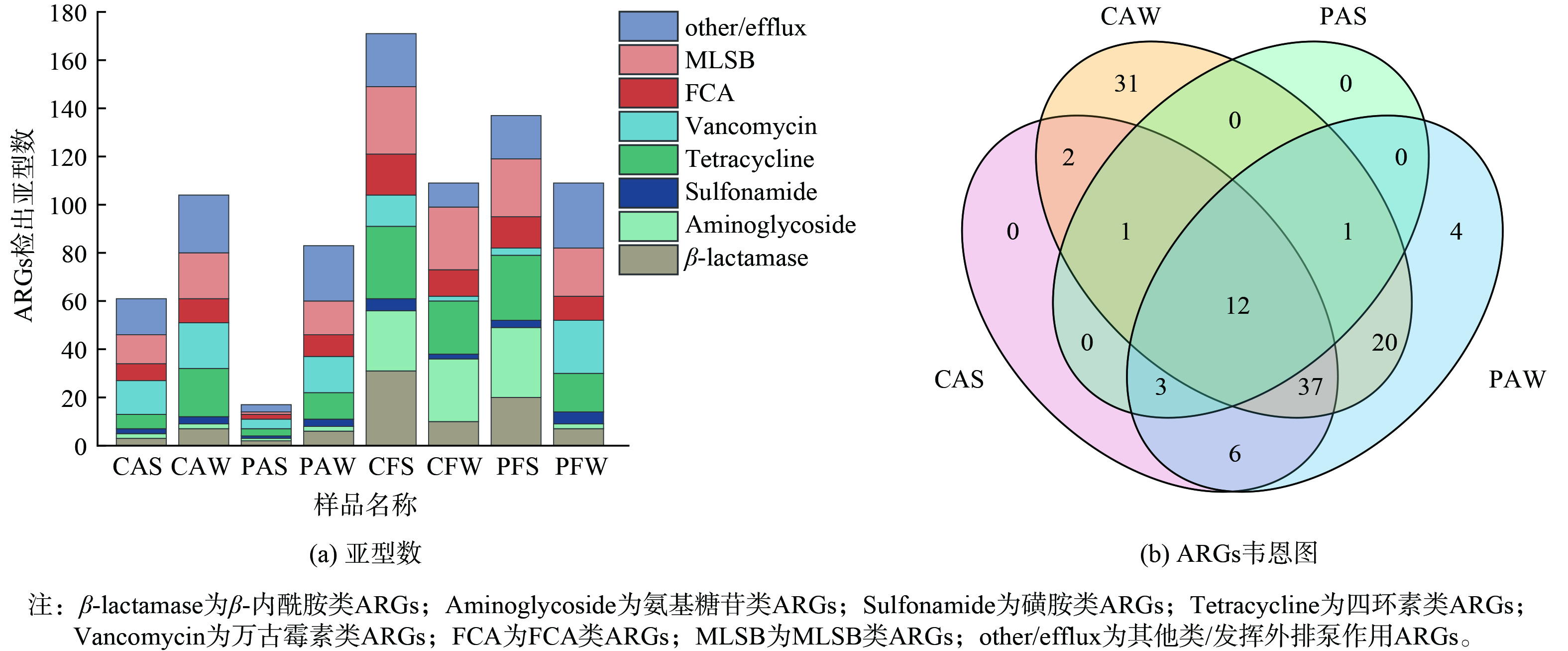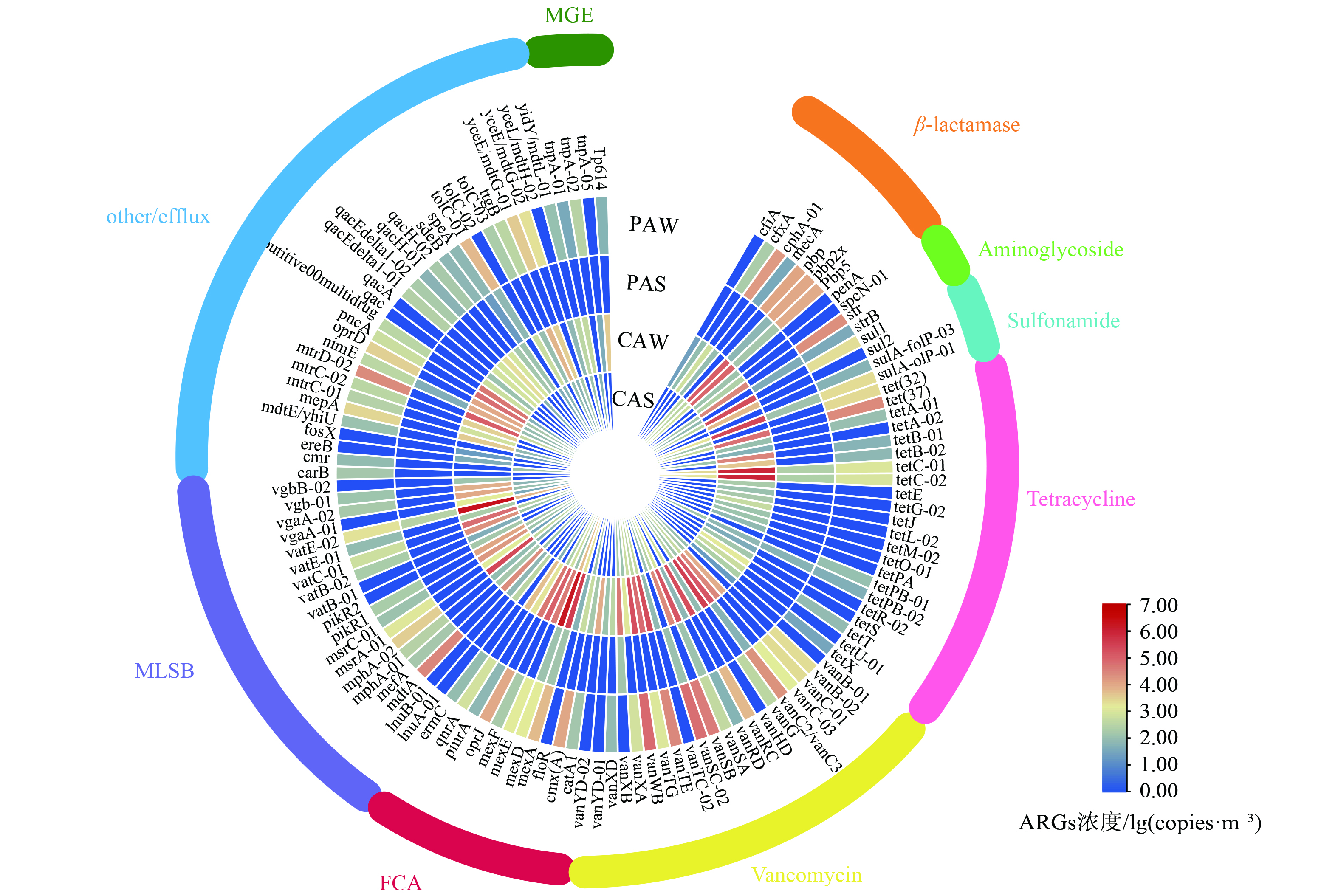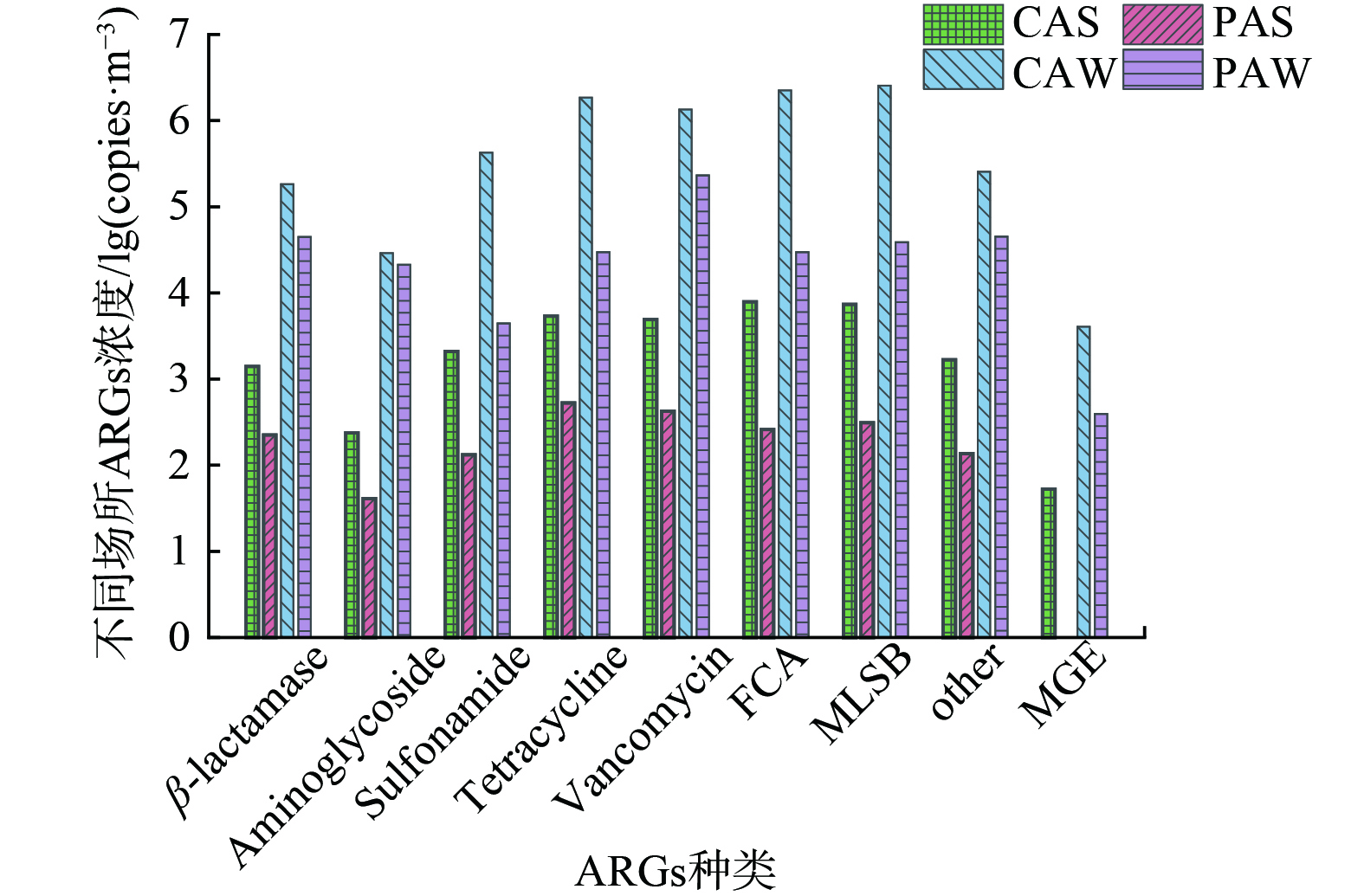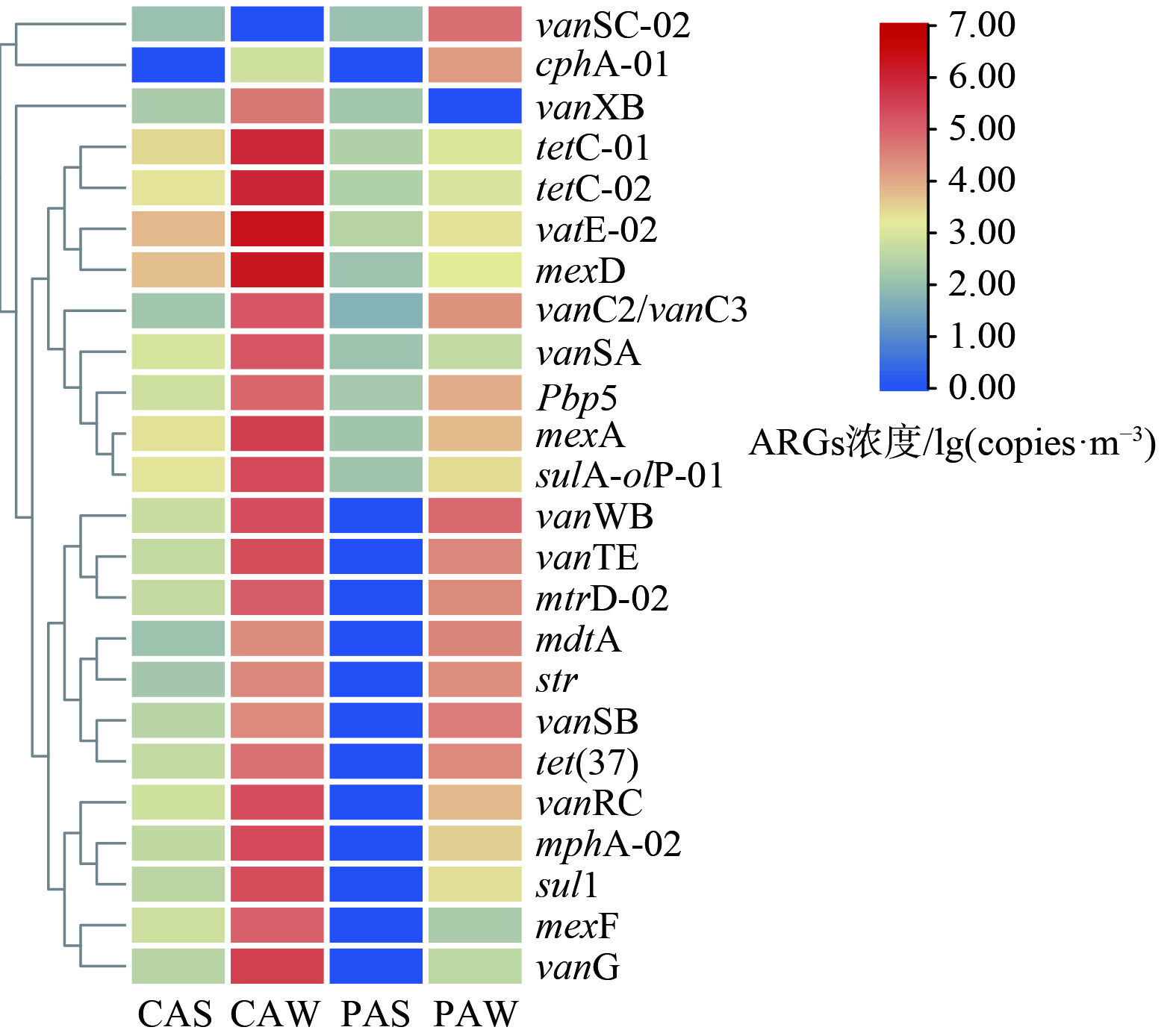-
随着畜禽养殖数量的激增,畜禽养殖场对抗生素的需求大幅增加。VAN BOECKEL等[1]调查发现大量抗生素在畜牧行业中被使用,比例约为73%。2013年,我国畜牧行业共使用了162 000 t抗生素。其中,84 240 t用于动物饲养活动。然而,抗生素进入动物体内后只能少部分吸收代谢,仍有大量抗生素通过排泄物进入环境中。通过长期的积累与环境选择性压力的不断诱导,畜禽养殖场中会产生大量抗生素抗性基因 (ARGs) 及耐药性细菌 (ARB,antibiotic resistance bacteria) [2],导致养殖场成为了ARGs携带菌的热点场所。
猪粪和鸡粪中均存在大量的ARGs产生和传播[3-5],而粪便中的ARGs还可通过气溶胶化进入空气中[6]。空气中的微生物气溶胶和细颗粒物是携带ARGs的耐药菌从牲畜向人类传播的主要途径之一[7-8]。一旦空气中携带ARGs的致病菌被人体吸入,将对人群健康产生影响。ARGs可通过包括质粒、整合子、转座子和噬菌体在内的可移动遗传元件 (mobile genetic elements,MGEs) 在同种属或不同种属之间进行水平转移 (horizontal gene transfer,HGT) ,并且可能转移到致病菌 (如肺炎链球菌、金黄色葡萄球菌和铜绿假单胞菌) 中,进而严重威胁人群健康[9]。因此,HGT可能会对整体抗性情况产生深远影响。ARGs可通过生物气溶胶进入环境中并进行远距离传播[10]。荷兰科学家研究发现,来自养殖场的ARB可能导致周围半径3 km内的居民暴露[11]。目前,ARGs在地表水和土壤2种常见介质中的传播已被充分研究[10, 12-13],而极少有研究关注畜禽养殖场空气中的ARGs分布特征。
本课题组选取陕西省渭南市规模化养殖的养鸡场和养猪场为研究对象,探究畜禽养殖场中气载ARGs的分布情况、不同类型 (鸡场和猪场) 的养殖场中气载ARGs的污染特征、养殖场中气载ARGs的季节性 (冬季和夏季) 变化,从而分析养殖场中气载ARGs与环境因素的相关性,以期为控制我国畜禽养殖场中气载ARGs污染的传播与防控提供参考,为空气环境生态风险评估提供依据。
-
选取陕西省渭南市猪场和鸡场为研究对象。这2个养殖场采用集约化养殖方式,均未设置机械净化系统。样品信息如表1所示。在夏季养殖场内通过工业风扇通风,在冬季采用加热设备调节温度。鸡舍的占地面积为20 m×11 m,高3 m;猪舍的占地面积为26 m×7 m,高3 m。
养殖场内空气样品使用中流量采样器 (TH-150F,武汉天虹仪器有限公司) 。采样流量为100 L·min−1,采集时间为6 h,采样器距离地面1.5 m。玻璃纤维滤膜经121 ℃灭菌20 min。鸡舍内每天进行2~3次机械清粪,猪舍每天2次人工清粪。在鸡舍和猪舍内通过四点采样法采集未经任何处理的新鲜的鸡粪和猪粪,在鸡舍或猪舍内随机布置4个采样点,采样后迅速搅拌混匀作为均一样本。分别在冬季 (2月) 和夏季 (8月) 对养猪场和养鸡场的空气和粪便连续采样3 d,将测得的平行样本数据取平均值进行分析。在采样同时,使用温湿度计监测养殖厂内的温度和湿度,使用风速仪监测风速。PM2.5使用重量法进行测定。
-
使用FastDNA® Spin Kit for Soil 试剂盒( MP Biomedicals,美国)提取DNA。将含有气体样品的玻璃纤维滤膜的1/8剪碎并进行超声处理,以保证最佳提取效率[14]。称取粪便样本 (约0.5 g) 添加到试剂盒中的 Lysing Matrix E tube,按照生产商提供的方法提取DNA。使用紫外-可见分光光度计 (Q5000; Quawell, USA) 测定DNA浓度。将提取的DNA样品置于−20 ℃冰箱保存。
-
本实验采用Wafergen SmartChip Real-time PCR系统进行HT-qPCR (High Throughput-qPCR) 。共使用296种引物对提取的DNA进行扩增,这些引物包括283个ARGs引物,12个MGEs引物和16S rRNA引物[15]。每种引物包括1个阴性对照。HT-qPCR反应条件为:95 ℃预变性10 min;95 ℃变性30 s,60 ℃退火30 s,共进行40个循环[16]。熔解曲线由Wafergen软件自动生成。
-
HT-qPCR的基因拷贝数 (gene copies number,后文缩写为GCN) 的计算方法参照Looft等[17]的方法,用公式 (1) 进行计算.
式中:CT为HT-qPCR数据,31为样品检测限。 HT-qPCR数据采用Excel 2019与SPSS 27进行计算与分析,并采用Origin 2023制图。
-
使用HT-qPCR对畜禽养殖场空气及粪便样品中的283种ARGs进行检测。将ARGs根据耐抗生素的类型分为8类:β-内酰胺类ARGs (β-lactamase) 52个;氨基糖苷类ARGs (Aminoglycoside) 36个;磺胺类ARGs (Sulfonamide) 7个;四环素类ARGs (Tetracycline) 39个;万古霉素类ARGs (Vancomycin) 32个、氟喹诺酮类-氯霉素类-胺酰醇类ARGs (FCA) 24个;大环内酯类-林肯酰胺类-链阳性菌素B类ARGs (MLSB) 44个;其他类/发挥外排泵作用ARGs (other/efflux) 49个。通过分析畜禽养殖场环境中检出ARGs亚型数发现四环素类抗性基因、万古霉素类抗性基因和MLSB类抗性基因是养殖场环境中的主要检出类型,分别占总检出类型的16.51%、14.33%、17.10% (图1 (a) )。此外,通过Venn图进一步分析了ARGs在畜禽养殖场空气中的相互关系 (图1 (b) ) ,结果表明有12种ARGs在所有空气样品中均有检出,其中主要的是四环素类抗性基因。这可能是由于四环素为广谱抗生素,且价格低廉,被广泛应用于养殖行业中[18]。
图2展示了所有样品中每种ARGs的浓度。在畜禽养殖场空气样品中的每种ARGs浓度可达到103~106 copies·m−³,在粪便样品中浓度可达到107~108 copies·g−1,空气中的ARGs浓度以万古霉素类、MLSB类、四环素类、FCA类ARGs为主,分别占总浓度的 (25.88%±17.52%) (5.28×102~1.85×106 copies·m−3) 、 (19.06%±8.88%) (2.59×102~2.24×106 copies·m−3) 、 (17.64%±8.06%) (1.32×102~4.25×105 copies·m−3) 、 (17.50%±9.73%) (4.23×102~1.35×106 copies·m−3) 。粪便中的ARGs浓度以四环素类、MLSB类和氨基糖苷类ARGs为主,分别占总浓度的 (22.12%±13.93%) (9.46×106~1.38×108 copies·g−1)、 (28.40%±15.22%) (2.14×107~1.44×108 copies·g−1)、 (17.28%±9.63%) (1.26×107~1.18×108 copies·g−1) 。畜禽养殖场内的动物粪便是养殖场内空气中微生物的主要来源[19],由于不同的ARGs的潜在宿主菌存在差异[20],而不同种类ARB的气溶胶化能力亦有差别,故空气样品中的主要ARGs种类与粪便样品中的亦存在差异。
-
分析养鸡场和养猪场ARGs种类和各亚型浓度分别如图3和图4所示。结果表明,不同养殖场中气载ARGs的污染特征存在差异,气载ARGs的平均浓度趋势为:养鸡场>养猪场。在检出亚型方面,养鸡场总检出亚型数比猪场多33种。养鸡场空气样品中总体浓度比养猪场高约1个数量级。其中,FCA类、MLSB类、磺胺类抗性基因在养鸡场空气中的平均浓度为1.12×106 copies·m−3、1.27×106 copies·m−3、2.13×105 copies·m−3,比养猪场 (1.51×104 copies·m−3、1.96×104 copies·m−3、2.29×103 copies·m−3) 高约2个数量级。因此养鸡场中ARGs对环境产生威胁的可能性更大。
值得注意的是,在猪场和鸡场检出的万古霉素类抗性基因、β-内酰胺类抗性基因、氨基糖苷类抗性基因浓度均相近。其中,万古霉素类抗性基因的浓度高达105 copies·m−3,万古霉素 (C66H75Cl2N9O24) 属于糖肽类抗生素,万古霉素类抗性基因的高浓度检出暗示养殖场环境中存在较高的生态健康风险及人体健康暴露风险。因此,应加强对畜禽养殖行业相关糖肽类抗生素的添加及使用管理,以控制畜禽养殖场内空气环境中相关ARGs的污染情况。
-
通过分析畜禽养殖场中冬季和夏季ARGs种类(图4)和亚型(图5),结果发现冬季空气样品中各ARGs种类及亚型的检出数量及平均浓度均显著高于夏季空气样品。其中,冬季畜禽养殖场中的空气样品检出的亚型数比夏季空气样本多55种。冬季样品中的四环素类、万古霉素类、MLSB类抗性基因分别比夏季空气样本多11种、8种、10种,而氨基糖苷类和磺胺类ARGs在夏季于冬季空气样本中检出亚型数几乎相同。这说明四环素类和MLSB类抗性基因的检出类型受季节影响较大。通过对比冬季和夏季空气样本中ARGs的浓度发现冬季样本中的总ARGs浓度 (4.67×106 copies·m−3) 高于夏季 (1.65×104 copies·m−3) 约2个数量级,且每种ARGs在冬季均高于夏季2~3个数量级。
在冬季,为了保持畜禽养殖场内的温度而减少通风,因此使得室内空气中的ARGs不断富集;而在夏季,养殖场内通常使用机械通风等方式进行降温,养殖场内空气流动性高于冬季,这可能导致了气载ARGs的稀释。其次,冬季畜禽养殖场中PM2.5的平均质量浓度为513.3 μg·m−3,夏季为105.68 μg·m−3,存在较大差异。又由于PM2.5可作为细菌和ARGs的载体[21],故可能会对ARGs的检出类型和浓度产生影响。另一方面,耐药细菌作为ARGs的宿主也会受到季节性变化的影响,冬季气溶胶中具有抗生素耐药性的细菌数量远多于夏季[22],进而影响到ARGs的种类和浓度。这亦证明了畜禽养殖场气溶胶中ARGs对人群健康的危害不应被忽视。
-
畜禽养殖场采集样品的环境监测数据如表2所示,冬季和夏季的温度与PM2.5相差较大,而湿度和风速相差不大。图6展示了代表性ARGs亚型浓度、总MGE浓度、总ARGs浓度以及环境因子的Pearson相关性。选取每个样品中的Top10 ARGs亚型,且为了避免偶然性,选取在每个样品中均有检出的ARGs作为代表性ARGs亚型。图6表明,总ARGs及多种ARGs亚型与PM2.5呈显著相关关系,与温度呈正相关,与其他环境因素几乎没有相关性。这表明PM2.5可能是影响畜禽养殖场中气载ARGs的重要因素。Pbp5、mexA与总MGEs浓度具有显著相关性 (p<0.05) 。这表明这些ARGs亚型在畜禽养殖场空气环境中通过MGEs的水平转移可能性较大。Pbp5、VanC2/VanC3与总ARGs具有显著相关性,故这2种ARGs可作为养鸡场和养猪场中检测气载ARGs的指示型ARGs (表3) 。然而,由于一些清粪频率、抗生素或其他药物的的投加量等人为行为及粪便中微生物的气溶胶化水平、养殖场动物呼出气中微生物群落特征等生物物理过程均可能会引起畜禽养殖场中气载ARGs的产生、传播和转移的改变,因此应对各种因素间的互作关系展开进一步研究。
-
1) 鸡场中的气载ARGs亚型数比猪场多33种,其中主要为MLSB、Vancomycin类ARGs;在畜禽养殖场中,冬季气载ARGs的亚型数比夏季多55种其中主要为Tetracycline类ARGs。
2) 鸡场中的气载ARGs浓度均高于猪场,尤其是鸡场中FCA及MLSB类ARGs的浓度高于猪场约2个数量级;在畜禽养殖场中,冬季气载ARGs的浓度均高于夏季约2~3个数量级。
3) PM2.5与畜禽养殖场中气载ARGs浓度呈显著正相关,Pbp5、VanC2/VanC3可以作为长期监测畜禽养殖场中气载ARGs的指示型ARGs。
不同畜禽养殖场中气载抗生素抗性基因的污染特征与季节性变化
Pollution characteristics and seasonal variation of airborne antibiotic resistance genes in different livestock farms
-
摘要: 由于大量的抗生素被用于畜禽养殖行业,畜禽养殖场中的抗生素抗性基因 (ARGs,Antibiotic resistance genes) 问题正逐渐变得严重。为调查畜禽养殖场中气载ARGs的污染特征及季节性变化,分别在冬季和夏季采集陕西省渭南市养猪场和养鸡场的空气和粪便样品,分析不同种类气载ARGs的污染水平及ARGs与环境因子的相关性。结果表明:畜禽养殖场空气中主要检出的ARGs类型为万古霉素类抗性基因、MLSB类抗性基因、四环素类抗性基因、FCA类抗性基因;在不同类型养殖场中气载ARGs总浓度趋势为养鸡场>养猪场,且养鸡场中每种ARGs浓度比养猪场中高约2个数量级;在不同季节养殖场中,气载ARGs总浓度趋势为冬季>夏季,且每种ARGs在冬季均高于夏季2~3个数量级。Pearson相关性分析结果表明,养殖场中气载ARGs总浓度与PM2.5呈显著相关 (P<0.05) ,与其他环境因子无显著相关性。本研究成果可为控制畜禽养殖场中气载ARGs污染的传播及防控提供参考。Abstract: In recent years, antibiotic resistance genes (ARGs) in livestock farms have attracted widespread attention due to the massive use of antibiotics. In this study, in order to investigate the pollution characteristics and seasonal changes of airborne ARGs in livestock farms, air and fecal samples were collected from pig farms and chicken farms in Weinan, Shaanxi Province in winter and summer, respectively. The pollution levels of airborne ARGs and the correlation between ARGs and environmental factors in all samples were analyzed. The results showed that the main types of airborne ARGs detected in livestock farms were vancomycin resistance genes, MLSB resistance genes, tetracycline resistance genes and FCA resistance genes. The total concentration of airborne ARGs in different types of farms was higher in chicken farms than in pig farms, and the concentration of ARGs in chicken farms was about 2 orders of magnitude higher than that in pig farms. The total concentration trend of airborne ARGs in different seasons was: winter > summer, and the concentration of ARGs in winter was 2~3 orders of magnitude higher than that in summer. In addition, pearson correlation analysis showed that the total concentration of ARGs in air was positive correlated with PM2.5 (P<0.05), but had no significant correlation with other environmental factors.
-

-
表 1 样品信息
Table 1. Information of the samples
样品编号 季节 养殖场类型 样品类型 WPA 冬季 猪场 空气 SPA 夏季 猪场 空气 WCA 冬季 鸡场 空气 SCA 夏季 鸡场 空气 WPF 冬季 猪场 粪便 SPF 夏季 猪场 粪便 WCF 冬季 鸡场 粪便 SCF 夏季 鸡场 粪便 表 2 鸡场和猪场在冬、夏季环境监测数据
Table 2. Environmental monitoring data of chicken farm and pig farm in winter and summer
样品编号 温度/ ℃ 湿度 风速/(m·s−1) PM2.5/(μg·m−3) CAS 29.97±1.57 98.07%±3.45% 0.01±0.01 99.16±39.05 CAW 7.70±1.25 94.83%±4.10% 0.00±0.00 588.93±160.72 PAS 31.16±1.27 86.07%±19.56% 0.01±0.01 112.20±29.49 PAW 6.2±0.95 87.50%±18.54% 0.00±0.00 437.67±170.46 表 3 ARGs与MGEs线性拟合方程
Table 3. Linear fitting equation of ARGs and MGEs
y x 相关系数 线性方程 ΣMGEs Pbp5 0.991* y=0.05x−9.58 (R2=0.999 8) ΣMGEs mexA 0.987* y=0.01x+1.20×102 (R2=0.994 1) ΣARGs Pbp5 0.996* y=113.33x−1.84×105 (R2=0.997 1) ΣARGs VanC2/VanC3 0.998* y=66.27x−2.55×105 (R2=0.990 7) -
[1] VAN BOECKEL T, PIRES J, SILVESTER R, et al. Global trends in antimicrobial resistance in animals in low-and middle-income countries[J]. Science, 2019, 365(6459): eaaw1944. doi: 10.1126/science.aaw1944 [2] ZHAN N, XIAO N. LivestockWaste 2016-International Conference on Recent Advances In Pollution Control and Resource Recovery for the Livestock Sector[J]. Frontiers of Environmental Science & Engeering, 2017, 11(3): 16. [3] LI W L, YANG J S, ZHANG D Z, et al. Concentration and community of airborne bacteria in response to cyclical haze events during the fall and midwinter in Beijing, China [J]. Frontiers in Microbiology, 2018, 9.https://doi.org/10.3389/fmicb.2018.01741. [4] HEUER H, SCHMITT H, SMALLA K. Antibiotic resistance gene spread due to manure application on agricultural fields[J]. Current Opinion in Microbiology, 2011, 14(3): 236-243. doi: 10.1016/j.mib.2011.04.009 [5] 董子琨. 鸡粪施用土壤中抗生素抗性基因在土壤-植物系统的迁移与阻控研究 [D]. 泰安: 山东农业大学, 2022. [6] MCEACHRAN A D, BLACKWELL B R, HANSON J D, et al. Antibiotics, bacteria, and antibiotic resistance genes: Aerial transport from cattle feed yards via particulate matter[J]. Environmental Health Perspectives, 2015, 123(4): 337-343. doi: 10.1289/ehp.1408555 [7] LI J, CAO J J, ZHU Y G, et al. Global survey of antibiotic resistance genes in air[J]. Environmental Science & Technology, 2018, 52(19): 10975-10984. [8] MBARECHE H, VEILLETTE M, PILOTE J, et al. Bioaerosols play a major role in the nasopharyngeal microbiota content in agricultural environment[J]. International Journal of Environmental Research and Public Health, 2019, 16(8): 1375. doi: 10.3390/ijerph16081375 [9] MONROE S, POLK R. Antimicrobial use and bacterial resistance[J]. Current Opinion in Microbiology, 2000, 3(5): 496-501. doi: 10.1016/S1369-5274(00)00129-6 [10] HE L Y, HE L K, LIU Y S, et al. Microbial diversity and antibiotic resistome in swine farm environments[J]. Science of the Total Environment, 2019, 685: 197-207. doi: 10.1016/j.scitotenv.2019.05.369 [11] DE ROOIJ M M T, HOEK G, SCHMITT H, et al. Insights into livestock-related microbial concentrations in air at residential level in a livestock dense area[J]. Environmental Science & Technology, 2019, 53(13): 7746-7758. [12] WANG J, QIN X, GUO J B, et al. Evidence of selective enrichment of bacterial assemblages and antibiotic resistant genes by microplastics in urban rivers[J]. Water Research, 2020, 183: 116113. doi: 10.1016/j.watres.2020.116113 [13] AMARASIRI M, SANO D, SUZUKI S. Understanding human health risks caused by antibiotic resistant bacteria (ARB) and antibiotic resistance genes (ARG) in water environments: Current knowledge and questions to be answered[J]. Critical Reviews in Environmental Science and Technology, 2020, 50(19): 2016-2059. doi: 10.1080/10643389.2019.1692611 [14] SONG L, WANG C, WANG Y Z. Optimized determination of airborne tetracycline resistance genes in laboratory atmosphere[J]. Frontiers of Environmental Science & Engineering, 2020, 14(6): 39-49. [15] ZHU Y G, JOHNSON T A, SU J Q, et al. Diverse and abundant antibiotic resistance genes in Chinese swine farms[J]. Proceedings of the National Academy of Sciences of the United States of America, 2013, 110(9): 3435-3440. doi: 10.1073/pnas.1222743110 [16] WANG F H, QIAO M, SU J Q, et al. High throughput profiling of antibiotic resistance genes in urban park soils with reclaimed water irrigation[J]. Environmental Science & Technology, 2014, 48(16): 9079-9085. [17] LOOFT T, JOHNSON T A, ALLEN H K, et al. In-feed antibiotic effects on the swine intestinal microbiome[J]. Proceedings of the National Academy of Sciences of the United States of America, 2012, 109(5): 1691-1696. doi: 10.1073/pnas.1120238109 [18] ZHANG Q Q, YING G G, PAN C G, et al. Comprehensive evaluation of antibiotics emission and fate in the river basins of China: Source analysis, multimedia modeling, and linkage to bacterial resistance[J]. Environmental Science & Technology, 2015, 49(11): 6772-6782. [19] CAMBRA-LOPEZ M, TORRES A G, AARNINK A J A, et al. Source analysis of fine and coarse particulate matter from livestock houses[J]. Atmospheric Environment, 2011, 45(3): 694-707. doi: 10.1016/j.atmosenv.2010.10.018 [20] SONG L, WANG C, JIANG G Y, et al. Bioaerosol is an important transmission route of antibiotic resistance genes in pig farms[J]. Environment International, 2021, 154: 106559. doi: 10.1016/j.envint.2021.106559 [21] 刘菲. 肉鸡饲养场PM2.5、粪便和土壤中抗生素抗性基因污染特征及抗生素耐药菌的分布 [D]. 常州: 常州大学, 2019. [22] 贾世杰, 王娇, 王钦, 等. 青岛冬春季大气气溶胶中抗生素抗性基因组成及影响因子[J]. 中国海洋大学学报(自然科学版), 2022, 52(8): 60-70. doi: 10.16441/j.cnki.hdxb.20210121 -




 下载:
下载:






